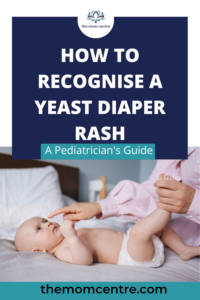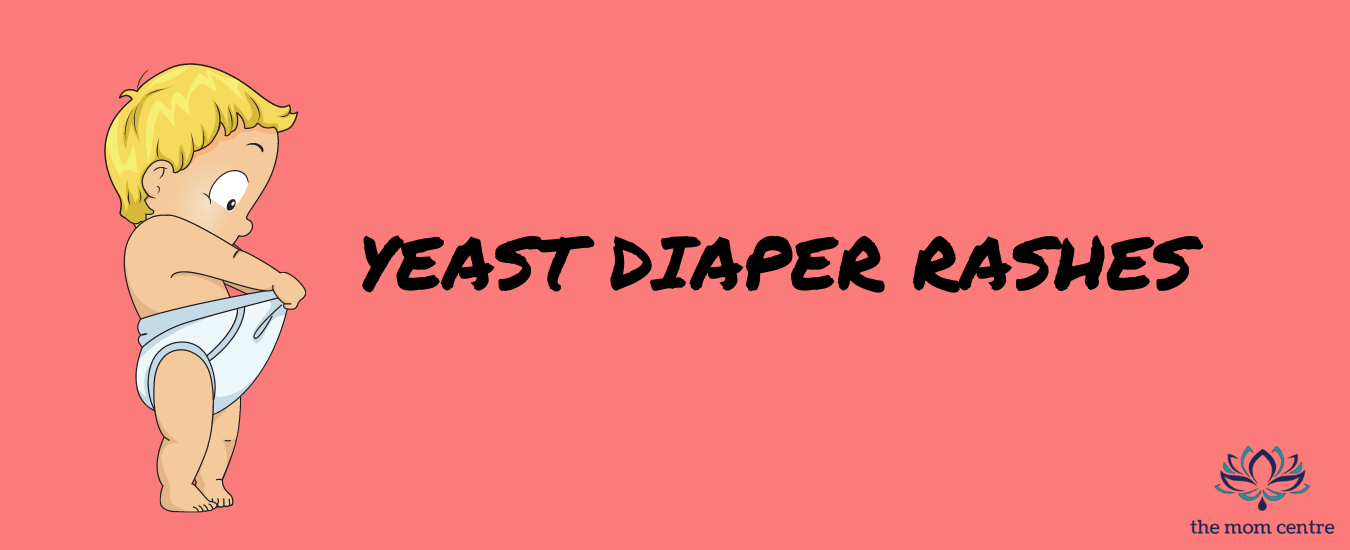Diaper rashes are something almost every parent has encountered at some point. Most diaper rashes occur because of irritation and damage to the skin because of the prolonged contact with feces and urine. These are known as Irritant Diaper Dermatitis.
These rashes are usually mild to moderate and respond well to home treatment. To know in detail how to treat diaper rashes read our article Diaper rashes: the ultimate guide.
On the other hand, yeast or candidal diaper rashes can mimic an irritant type of diaper rash but, fail to resolve even after a few days. Yeast diaper rashes can get progressively worse, and usually require a consultation with a healthcare professional.
Table of Contents
What are yeast diaper rashes?
Yeast or candida is a type of fungi that is present on our skin as natural inhabitants. These fungi can sometimes overgrow and cause infection.
Diapers can act as a good environment to breed yeast infection. The warmth and increased moisture inside a diaper can damage the topmost skin layer. This is the most important factor that can predispose to yeast infection.
What do Candidal diaper rashes look like?
As a parent Yeast diaper rashes may look strikingly similar to common diaper rash and can be difficult to differentiate. However certain clues on close examination can help you determine if you are dealing with a yeast diaper rash from the get-go.
Yeast or Candidal diaper rash
- presents with bright red plaques that have white scales.
- The rash involves the creases between the thigh and groin called the inguinal crease, unlike an irritant rash which usually spares these creases.
- They also characteristically have something called “satellite lesions”. These are lesions that have extended beyond the large diaper rash and appear as pustules around the margin of the main rash. (see reference image)
How can I differentiate an irritant diaper rash from a yeast diaper rash?
Any parent dealing with diaper rashes should always confirm that it is a simple irritant diaper rash and not the yeast diaper rash as the treatment differs. See our simple yet easy guide below.

Is my baby at risk of yeast diaper rashes?
Certain babies are at increased risk of candidal diaper rashes than others. The risk factors are as following
- Babies with damaged skin, which can be due to any other rash-like irritant diaper rash or allergic diaper rash.
- Babies on antibiotics currently or have recently completed an antibiotic course
- Babies with recent or ongoing diarrhoeal episodes
- Babies on high potency steroid creams especially for irritant or allergic diaper rashes.
How to treat yeast diaper rashes?
Yeast diaper rashes require antifungal creams and ointments to resolve. These are usually prescribed by your doctor.
In addition to the prescribed medications,you can follow the ABCDE method to treat the rash easily and effectively.
Air
The most effective treatment of diaper rash is airing out the rash. Do away with the diapers altogether. This ensures that no further irritation or bacterial contamination occurs and also maintains dryness.
Barrier
in addition to antifungal creams, use a barrier diaper paste or ointment to protect the skin from ongoing irritation like stool or urine. Use a generous amount and create a thick layer over the rash. These should contain zinc oxide that soothes and acts as an effective barrier from further damage.
Clean
Keep skin clean.
Wash your hands before and after a diaper change. Bacterial contamination of a diaper rash can make the rash much worse.
Use clean warm water with a soft cotton cloth to clean the area. Be extremely gentle and use dabbing motions instead of rubbing.
If the rashes are severe and the skin is peeling then use warm water in a squeeze bottle to wash out the area and gently dab to dry. Never rub or wipe the area.
Disposable diapers
While being diaper-free is most suitable, if you absolutely must use a diaper then use a disposable diaper which is one or two sizes larger during an episode of diaper rash.
This is particularly important if you regularly use cloth diapers. Do not use rubber or plastic-based reusable diapers.
Educate
The best way to treat diaper rash is to prevent one. Educate yourself about how to prevent a recurrence of diaper rash. Read our guide on how to
When to see a doctor?
Yeast diaper rashes require immediate medical attention as these require specific medicated creams to be treated. If your baby has a diaper rash always make sure to look for signs of yeast infection.
When in doubt, always seek medical advice.
A regular (irritant) diaper rash can eventually get infected with yeast as well. Therefore, any diaper rash persisting beyond 72 hrs requires medical attention.
Read our full article on how to effectively treat irritant diaper rashes
Also, any following signs even in regular diaper rash warrants a doctor’s consultation
- If your child develops any sign of infection like fever, refusal of feeds, decreased activity.
- If the rash extends beyond the diaper area.
- Rash that has pus or pus-filled blisters or deep ulcers.
- Blood in stools.
FAQs
Depending on the severity of the rash and its effect on your baby, your doctor might prescribe antifungal cream with or without antifungal oral medications. Severe and stubborn yeast diaper rashes do sometimes require oral antifungal medications.
Most yeast diaper rashes respond well to creams and rarely require oral medications. However rarely yeast diaper rashes can sometimes get infected with bacteria which worsens the rash and requires further treatment with antibiotics as well.
If the rash is very severe your doctor might advise hospitalization to ensure proper care of the rash involving aseptic dressings and administration of medications.
Yeast diaper rash unlike a simple irritant diaper rash may days to weeks to resolve completely.
- Frequent diaper changes
To avoid moisture and prolonged contact of urine or feces with skin it is important to change diapers frequently. So then comes the question, how frequently should I change the diapers?
While 2-4 hrs is an ideal period to change diapers, the appropriate answer would be to change as frequently as required. So it is extremely important to constantly check the diapers, especially if you are using cloth diapers, to make sure that cute little bottom isn’t sitting in too much moisture.
Most disposable diapers come equipped with moisture indicator strips that change color on contact with moisture.
- Use super-absorbent diapers
Diapering technology has seen a tremendous advancement in recent years and as a result, most diaper companies can produce diapers that promise good absorbency.
If you are environmentally conscious or simply are accustomed to cloth diapers then make sure to use multiple layers of skin-friendly material like pure cotton to increase the absorbency. Check frequently to make sure your baby is dry.
I always recommend cloth diapers during the day as its easy to keep an eye on, and disposable ones during the night when you and your baby both need a good night’s sleep.
- Cleaning with warm water
You can simply use warm water to clean the diaper area instead of store-bought baby wipes, which is not only safe and soothing, it’s also the most economical. There are of course water wipes that contain mostly water with other soothing agents which are also a good alternative.
- Rash cream
Since moisture is a risk factor for diaper rashes it is important to create an oil-based barrier to protect the skin. This can either be any moisturizing oil or emollient cream.
- Use gentle detergents
Detergent soaps can in general be a strong irritant, even more so for a baby’s delicate skin. Choose a gentle baby-friendly detergent or an after-wash cloth conditioner to wash away any harsh chemicals. Rinsing manually or using a rinse cycle in the washing machine also helps rinse away any harsh chemicals.
- Diaper-free time
Make sure you give your baby plenty of diaper-free time at regular intervals. Immediately after a bowel movement allows some diaper-free time for your child. You will get accustomed to their urine and bowel patterns and you will be able to judge and allocate a diaper-free time based on their routine.
1.Bacterial contamination.
Yeast diaper rashes can get secondarily infected with bacteria.
This is usually evident by the appearance of pus or pus-filled vesicles on the rash. It is also accompanied by the development of signs of infection like fever, refusal to feed, increased irritability, or decreased activity of the child.
- Resistance to topical medications
Yeast diaper rashes if severe in intensity may not always respond to creams and ointment and may require oral medications. However, this is very rare in children who are otherwise healthy and have no other risk factors.
- 3. Extension to other parts of the body
Rarely, the rash can spread to other parts of the body like mouth, skin, and blood. This requires immediate medical attention.
If you have any queries leave them in the comments below and we are always happy to help you.




